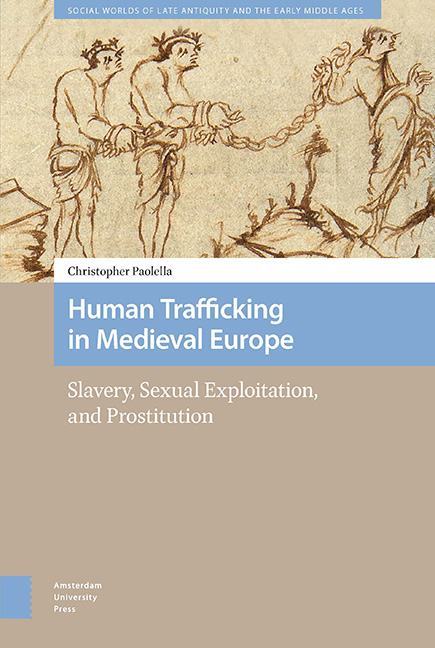4 - The High Medieval Pivot
Published online by Cambridge University Press: 21 November 2020
Summary
In this chapter, I argue that the socioeconomic changes of the twelfth and early thirteenth centuries laid the groundwork for permanent alterations in human trafficking patterns later in the thirteenth century. In this period, the networks slowly transitioned from supplying predominantly agricultural labor with legally enslaved victims to supplying predominantly sex labor with legally unenslaved victims (largely through illicit sales, coercion, and abduction) in Western Europe, north of the Alps and Pyrenees. The growth in monetary exchange, the popular internalization of Latin Christian identity, and the growing sense of spiritual community among Christians, all caused slavery as a means of compelling agricultural production to decline, but slavery itself nevertheless lingered in other forms, such as domestic slavery, and as a cultural and a legal category.
The revitalized monetary economy also encouraged an urban renewal across Western Europe that would incubate a growing commercial sex industry, which would in turn fuel a new demand for human labor. Thus the contours of late medieval human trafficking in Western Europe were sculpted in the twelfth and early thirteenth centuries, but the results of this shift in demand from agricultural labor to sex labor would only come to historical light in the decades that followed. Moreover, human trafficking continued to evolve in Northern Europe, Eastern Europe, and throughout the Mediterranean world. We must not, then, view Western Europe in isolation, because its socioeconomic changes would have far-ranging consequences for long-distance trafficking patterns elsewhere. Therefore, we will complete our surveys of the Northern and Southern Arcs and then consider the high medieval pivot.
As we have seen in Chapters One and Two, late antique and early medieval human trafficking networks intensified and abated over the course of time. We see, for example, an increase in long-distance, regional, and local trafficking activity in the late Empire, an abatement of long-distance trafficking and a continuation of regional and local trafficking between the sixth and eighth centuries, followed by an intensification of local, regional, and long-distance trafficking over the course of the ninth, tenth, and eleventh centuries. The networks’ relative independence of one another, the mutability of the roles of trafficking victims within medieval economic systems, and the overlap between slaver and trader, all allowed human trafficking networks to adapt to the many different socioeconomic and political environments in which they operated.
- Type
- Chapter
- Information
- Human Trafficking in Medieval EuropeSlavery, Sexual Exploitation, and Prostitution, pp. 167 - 214Publisher: Amsterdam University PressPrint publication year: 2020



